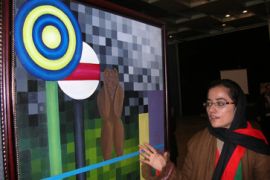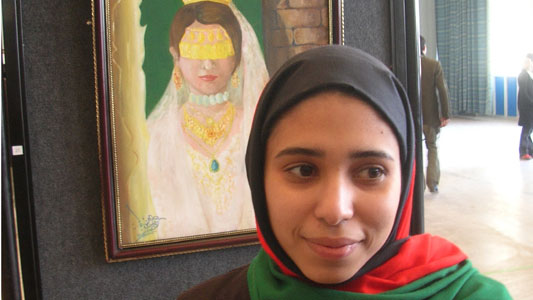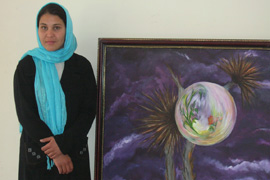Afghan women turn to art
After years of war and displacement, they find solace on canvas.

 |
| Women play a central role in Ommolbanin Shamsia’s paintings which are on display at Kabul’s Centre for Contemporary Arts [MOJUMDAR] |
On a dusty road in a middle class neighbourhood in west Kabul, an unassuming house looks almost as nondescript as any other except for the simple board declaring it is the Centre for Contemporary Arts in Afghanistan.
It is here that a quiet revolution is taking place. For the first time in the country’s recent history, a group of young women are learning to express their experiences, sorrows and joys growing up in war-ravaged Afghanistan through art
And they are producing remarkably sophisticated and eloquent work.
The originality of their imagination is even more extraordinary in the context of Afghanistan’s tragic history of conflict and the violence which continues to be visited upon women living in this country.
The Introvert
 |
| Yalda Noori, a student at the Centre, stands next to her painting ‘Life Passages’ |
Sheenkai Alam, a 19-year-old Afghan school girl is displaying ‘Introvert’, a painting which combines an array of colours in geometric shapes; circles, bars, and blocks fragment the colours. In the midst sits the figure of a man holding his head in his hands.
“He is the Afghan trying to find himself, the colours represent the mirror of history,” Alam told Al Jazeera.
Eschewing a formulaic approach for herself, she says: “What method of work I use does not matter much to me. What matters is what I have to say and how I can respond to my inner needs.”
“Some think that to paint they should possess innate skills, but I believe they should possess good knowledge, open vision and awareness which is of no less value than innate talent and skills,” she added.
Alam has tasked herself with expressing the state of the Afghan people following war, bloodshed and strife. She believes that Afghans are a peoples who have been robbed of their identity because of years of displacement, a plight she herself experienced as a refugee.
Her family only returned from life as refugees in the Pakistani border town of Peshawar five years ago.
Survival art
For the tens of thousands of refugees who tried to survive in makeshift camps dotting the Afghan-Pakistan border in the 1990s, there was little scope for creativity or learning traditional arts and crafts skills.
Art was an early victim of the violence and policies of successive governments in Afghanistan; if the Soviets stifled independent creativity, the mujahideen did not like the arts and the Taliban systematically destroyed what was left of it.
But now, despite continued violence in parts of Afghanistan, a small market for art has emerged, largely patronised by the Afghan elite and the expatriate community.
Most of what is available however reverts back to the traditional classical and representational art styles that existed before the 1979 Soviet invasion.
A lot of it caters to the stereotypes of Afghanistan – woman in blue burkhas, the Bactrian camel, the destroyed monuments.
They are symbolic of the repetitive picture post card clichés and the ubiquitous paintings of the famous Steve Mc Curry photograph of the green-eyed Afghan girl.
Artistic spirit
 |
| Rahraw Omarzad, himself a painter, runs the Centre for Contemporary Arts in Afghanistan |
Rahraw Omarzad, a former refugee and teacher at the Fine Arts Faculty in Kabul University, and his wife have been struggling to keep the Centre for Contemporary Art alive in hopes of galvanising a resurgent art community in Kabul.
“In this Centre I did not want [the students] to adopt one ‘ism’ over another. I did not want them to copy what they saw. So I have not taught them either technique or theory of modern art. They have created everything out of their own imagination and we discussed each painting on its merit,” he told Al Jazeera.
Expressing an independent sense of imagination is crucial for Omarzad who encourages his students to think beyond and away from the teacher and focus on self-expression as the guiding principle.
When one of Omarzad’s students created a ‘dance of colours’ she was unaware that she had stumbled upon a technique tried by world renown artists.
“I showed her Jackson Pollock’s work after she did her painting. She was amazed.”
Women expressing themselves
Unlike some Afghan youth whose families were able to go to the West, most of the women at the centre were refugees in neighbouring countries and lacked the benefits of a more sophisticated exposure to arts and culture.
Though Ommolbanin Shamsia, a 20-year old accounting student, has been painting since she was four years old, it is only at the centre that she first received formal art instruction.
She says there was little opportunity to learn art while living as a refugee in Iran. Her art work, like Alam’s is widely varied in subject and technique.
In one painting, one sees only the hemline of a woman’s dress and her feet at the edge of a pool of water. Reflected up from the water, however, is a young green tree.
“The woman is the regeneration of life; she represents rebirth, the beginning of life,” Shamsia says.
Despite some advances, such as increased visibility in schools and the workforce, the role of women in public spaces is very limited. Even Kabul, the Afghan capital, has no women shopkeepers and many women are only allowed out of their homes for the duration of their work – whether it is to their workplace or to school.
Afghanistan’s prisons hold women who are in jail for having left their homes without male permission or supervision since under the country’s customary laws women are part of the household possessions.
As a result, many budding female artists resort to painting in the privacy of their homes unlike other forms of art which may need public space.
But Omarzad believes that with such enterprises as the art centre, women may are beginning to find means to express themselves.
“Now that they have held their first exhibition and seen the response of the people they have confidence in their own creativity they and can learn about the history and techniques without becoming intimidated,” he said.
Excited about his students and their work, Omarzad says he is aware the Centre could face difficult times in near future.
“Until now no one knew about [the Centre]. I am sure when we are better known there will be some opposition from the conservative people who are against art and the participation of women.”